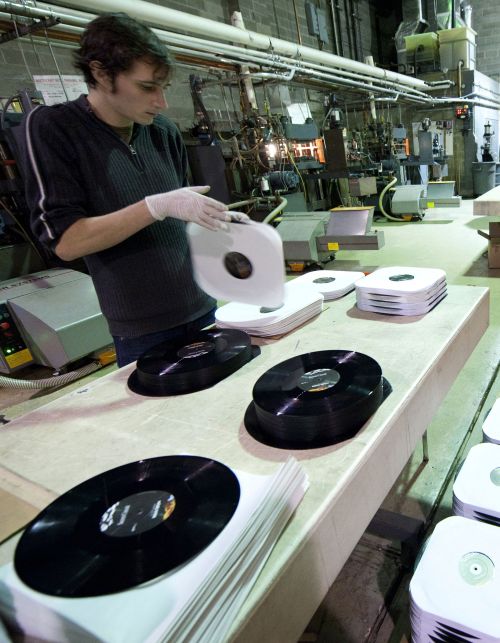NEW YORK (AFP) ― In today’s brave new world of MP3 players, compact discs are dying, cassettes are Stone Age, and old-fashioned vinyl records ... they’re back!
It might seem that nothing short of a wind-up gramophone could be more out of place today than the nostalgia-laden, crackly-sounding 33 and 45 RPM disc.
Yet in his Brooklyn, New York, factory, 40-year-old Thomas Bernich churns them out by the tens of thousands, feeding a vinyl revival that has record decks ― and cash tills ― spinning.
 |
Michael Quintain packages new records at a factory belonging to Thomas Bernich on Jan. 17 in New York. (AFP-Yonhap News) |
“It’s my baby,” Bernich said in his spartan office at Brooklynphono. “It’s growing.”
The small plant in a blue collar neighborhood hums with the sound of machines and spaghetti-like rows of pipes delivering ground-up vinyl to presses where the material reemerges as shiny albums etched with near-invisible, music-filled spirals.
Bernich started on a shoestring 10 years ago. Now he has four full-time employees and two part-time, manufacturing a quarter of a million discs a year, with plans to double capacity.
In an age of near-instant music downloads and entire libraries stored in gizmos the size of a cigarette lighter, the arcane process of making records defies convention.
But the market is vibrant.
Alan Bayer, who runs the online record store vinylrevinyl.com, said records refuse to go the way of the crumbling cassette tape or passe CD.
“The only music stores that have managed to stay in business in my area are ones that devote an important percentage of their stores to vinyl records,” he said in an email from California.
Purists swear that music sounds better from records than from compressed digital files. Collectors love the hunt for rare, scratch-free recordings, not to mention the art-filled sleeves.
Young DJs, or turntablists, turn their parents’ fusty old technology into the hippest of night-club tools, while bands looking to make a name for themselves commission records so that they can stand out in the sea of YouTube videos and downloads.
“We give the band a record, they make 300 records, then drive around the country for the summer playing and the records all get sold out of the back of the van,” Bernich said. Other than helping to create a fan base, fresh bands with a shiny record often find the labels “take them very seriously.”
Scott Neuman, president of ForeverVinyl.com, an appraisal service and dealer, said sales of newly minted records were for the first time overtaking those of pre-existing records.
Meanwhile, the pre-owned market, he said, “is being flooded” by people emptying out their basements in search of a quick buck.
Retailers will pay about 25 cents for a single, ordinary record or sleeve, then resell for between $1-5, he said. But more sought-after editions quickly go for $100 or far more.
Neuman said he’d got $10,000 for a rare sleeve to the Rolling Stones’ album “Street Fighting Man.” The cover, depicting a policeman beating a man, had been withdrawn soon after release because of complaints. Although thousands were made, only a handful survive.
“You have people who mine for gold and if they get an ounce of gold after digging in dirt for days and days they’re happy,” he said. “It’s like that.”
Vinyl fans say there’s also something in the physical attractiveness of the record and the ritual of using turntables that the MP3, like the CD, cannot match.
“It’s personal. You get to spend more time with the music,” said Jeff Ogiba, who opened Black Gold, a Brooklyn records store and coffee shop, 18 months ago.
“The last decade and a half has been an information age, so there are a lot of things that are intangible. People want to go out and have physically tangible things because now you press a button and a package comes to your door,” Ogiba said.
Bernich says making records is not all fun. “It’s very over-worked and underpaid,” he said.
And he likens the manufacturing process, dependent on variables such as air temperature and inconsistent chemical components in the vinyl, to “a moving target, a shot in the dark”.
But there is magic, too.
At Brooklynphono all of last year’s production was made from recycled records ― mountains of Neil Young discs and their ilk pulled from musty old cupboards and shelves, then smashed, melted, and reborn as the very latest releases.
When there are sound quality problems, Bernich will exchange the great, heaving machines of his shop floor for a microscope through which he can examine the music-filled grooves for flaws.
A lifelong mechanic with the heart of an artist, Bernich says record-making makes his world go round.
“I’m in a passionate state of mind,” he said.








